Woodturning Tools
| ToolInfoBox Woodturning Tools | |
|---|---|
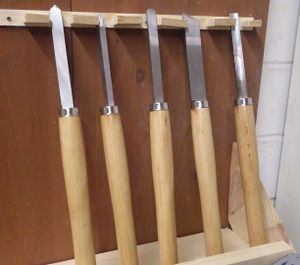
| |
| Synonyms: | DE: Drechseleisen, Drechselmesser |
| Material: | wood |
| Used with: | wood lathe |
| Location: | (soon) wall above wood lathe |
| Access Requirements: | upon personal introduction |
| Tutors: | Lukas |
Once you've got a nice turning blank spinning on the wood lathe, you'll want to shape it by holding something sharp to it. We're only getting started with woodturning, but as we learn this page will grow with information about various forms of turning tools (a multi-photo imagemap will be nice for easy navigation).
Lukas just got a cheap beginner's set consisting of
- some kind of 12 mm gouge
- not a roughing gouge: too narrow & shallow
- not a Formröhre: mostly rectangular when seen from above, no "nose"
- looks a lot like an out-cannel firmer gouge (not a turning tool?!)
- 26 mm skew chisel (Drechselbeitel)
- 13 mm round nose scraper (Schaber, rund)
- 4 & 6 mm parting tools (Abstechstähle)
that could use proper sharpening and a wall holder.
Gouges
| ToolInfoBox Woodturning Gouges | |
|---|---|
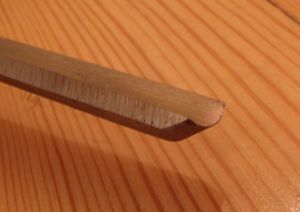
| |
| Synonyms: | DE: Drechselröhren, Drehröhren; Schruppröhren, Formröhren, Schalenröhren |
| Type: | woodturning tool |
| Material: | wood |
| Used with: | wood lathe |
| Access Requirements: | upon personal introduction |
| Tutors: | Lukas |
Gouges are perhaps the most frequently used woodturning tools and are very useful to get your workpiece round in the first place.
We only have a very uncharacteristic gouge at the moment. There are several specialized types including roughing, spindle and bowl gouges, all of which may be sharpened at different angles to produce an even bigger variety.
- basics: http://www.docgreenwoodturner.com/gouges1.html
- how to sharpen: https://www.youtube.com/watch?v=k-nTHpfcwkQ (first half)
- "detail" gouges: http://www.docgreenwoodturner.com/gouges7.html
Roughing Gouges
Avoid contacting the workpiece with one of the corners! These gouges are usually forged from a flat piece of steel and therefore less strong than those that are milled from a solid round piece - they are sometimes reported to break near the handle. [1]
This article may help you with your first attempts of using a spindle roughing gouge. Roughing gouges take the same shaving across their entire cutting edge so it's a good idea to keep slowly twisting the tool to balance the wear over the entire edge (otherwise you'll quickly have a dull spot in the middle while the sides are still sharp).
We do NOT have a shared roughing gouge yet, but you're welcome to bring one!

Spindle Gouges
Called "Formröhren" in German, these gouges are okay for rounding a spindle if you don't have a proper roughing gouge but are more suited for forming cuts in an already round workpiece.

Bowl Gouges
Bowl gouges are most aggressive at the sides, so you should avoid to contact the workpiece with the entire bevel. Instead, they are somewhat "rolled" into the desired cut position. This basic "tip cut" technique is nicely explained in this article.
advanced techniques
- with special "fingernail" or "swept-back" grinds, "wing cuts" are also possible for advanced turners
- sidegrain turning (needed to make bowls)
- steps of bowl turning

Skew Chisels
| ToolInfoBox Skew Chisels | |
|---|---|
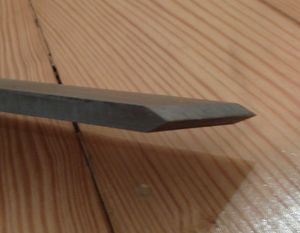
| |
| Synonyms: | woodturning chisels, "skews"; DE: Drechselbeitel, Drehmeißel, schräge Flachstähle |
| Type: | woodturning tool |
| Material: | wood |
| Used with: | wood lathe |
| Location: | (soon) wall above wood lathe |
| Access Requirements: | upon personal introduction |
| Tutors: | Lukas |
Not to be confused with "regular" bevel edge chisels!
Also called the "woodturner's plane" - can create nice surfaces, but prone to "catching" on the workpiece if you're not experienced!
Besides the video linked above, you should have a look at this nice writeup on how to control the skew and prevent catches before attempting to use it.
Once you get the hang of it, a skew chisel is actually a very versatile tool and can be used for a variety of different cuts.

Scrapers
| ToolInfoBox Woodturning Scrapers | |
|---|---|
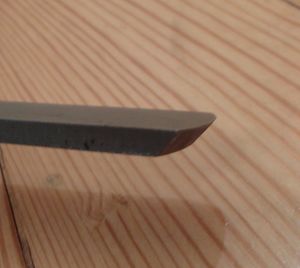
| |
| Synonyms: | DE: Schaber, Drechselschaber, Flachstähle, Schlichtstähle, Schrotstähle |
| Type: | woodturning tool |
| Material: | wood |
| Used with: | wood lathe |
| Location: | (soon) wall above wood lathe |
| Access Requirements: | upon personal introduction |
| Tutors: | Lukas |
| Similar (More or Less): | card scrapers |
Scrapers are not really used for cutting but have an edge with a burr similar to that on a card scraper. Instead of removing a lot of wood you can use this tool for delicate finishing touches. Read more about this tool here (Doc Green).
Contrary to pretty much all other woodturning tools, you do not let the scraper "ride" on its bevel. To make sure the workpiece always runs "away" from its edge and you do not get a catch, use this tool below the workpiece axis for outside work and above for inside work. [2]
We have one round nose scraper to start with.

Parting Tools
| ToolInfoBox Parting Tools | |
|---|---|
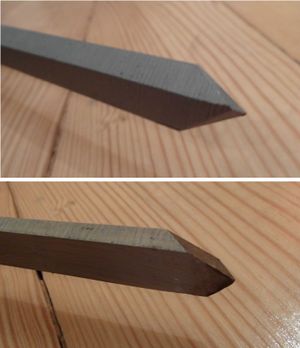
| |
| Synonyms: | DE: Abstechstähle, Abstecher |
| Type: | woodturning tool |
| Material: | wood |
| Used with: | wood lathe |
| Access Requirements: | upon personal introduction |
| Tutors: | Lukas |
Parting tools can be used for simple grooves or to "part off" your finished piece from the waste. However, parting can be very dangerous if the cut is not widened properly and the high friction causes the tool to get jammed in its cut! [3]
In many cases, and when working between centers, it is advisable to turn the lathe off and do the final parting cut with a saw instead.
When your blank has knots or split edges, a parting tool may be more suitable than a roughing gouge to get it round. [4]
=> Doc Green: Parting Tools
=> HolzWerken: Beim Drechseln oft unterschätzt - der Abstecher (DE)
Further Information
- thespruce.com
- Makezine: "7 Basic Woodturning Tools"
- Video Tutorials
- Understanding a Starter Set of Lathe Chisels - simple but safe techniques for beginners
